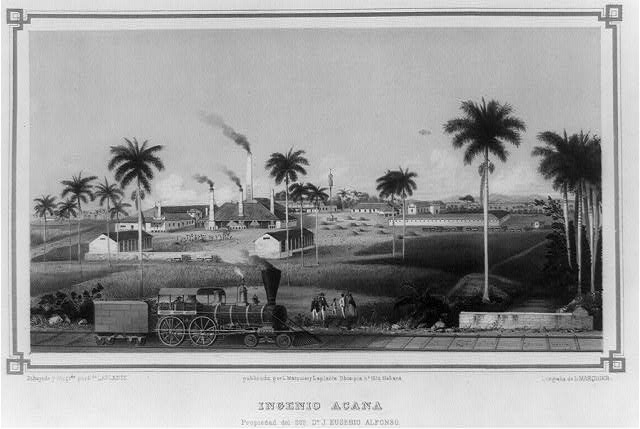
This print displays a Cuban sugarcane refinery plant and is from 1857. It was printed by Eduardo Laplante, who used lithography to do so, which is a method of printing based on the immiscibility of water and oil and is done on a flat metal or stone surface. It’s titled “Igenio Acana”, ingenio meaning ingenuity in English. Sugarcane was the most important cash crop for Latin American countries, including Cuba. However, the importance of this print lies not within crop, but the foreground: the steam locomotive. In the 1850’s, with the adoption of liberal governments, the idea of Progress came about. It was characterized by technological advancement sweeping across the formerly undeveloped nations of Latin America, industrializing everything in its path1.
Progress did a great deal for the economy in Cuba. Sugarcane mills were primarily in rural areas, and in the 19th century, travel between the rural fields and urban city centers was doable, but burdensome. The steam locomotive changed that. It made transporting goods from the countryside to the cities easy. People no longer had to trudge through trails with carts, whether they were manpowered or animal-drawn; instead, the goods were loaded on train cars and were efficiently shipped to urban areas. Alongside goods, people in the periphery could also be brought into cities much easier, increasing the economic interconnectedness of the Cuban population. Laplante most likely created this print to showcase the stark advancements in the Cuban economy, not only evidenced by the train, but also by the billowing smokestacks rising up from roof of the sugar mill, which would not have been found just a few years before.
1. John Charles Chasteen, Born in blood and fire, (New York W.W. Norton, 2016) 163-164.
Works Cited:
Chasteen, John Charles. Born in Blood and Fire. 4th edition. New York: W. W. Norton, 2016.
Laplante, Eduardo. “Ingenio Acana”.
By Shane Wallace
